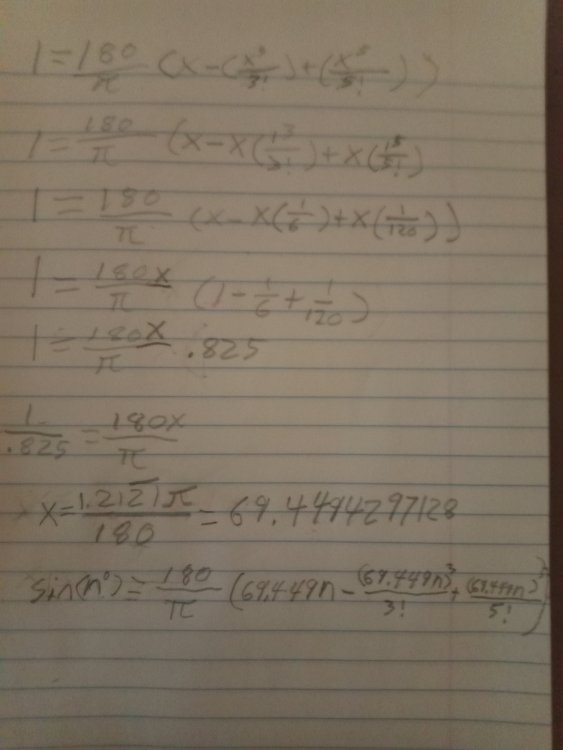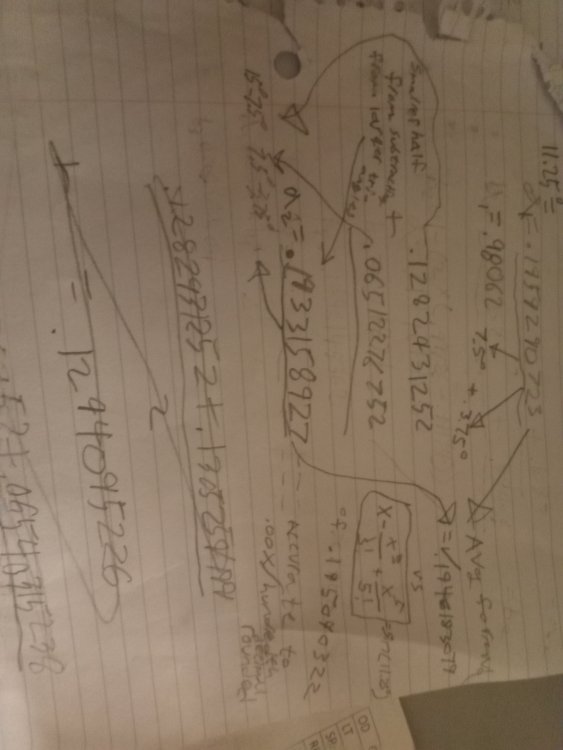

Engineeer
Senior Members-
Posts
35 -
Joined
-
Last visited
Content Type
Profiles
Forums
Events
Everything posted by Engineeer
-
This is nothing new, it is quite common to aspire to explain away all the forces as one force (mostly gravity). The elusive graviton could be the building blocks of all particles.
-
Cosmological redshift in receding galaxies can be explained away by the inverse square law of a gravitational field as it propagates outward and expands like like a ripple in a pond. The idea is that the water is filling in a gap as this happens, stretching the fabric of space. The residual background radiation can be explained by the annihilation of all the antimatter generated with the matter at set point in time in which both accumulated in cardinal infinitudes.
-
Okay that's still wrong for some reason So if you scroll up to the first two images I posted you'll see the polymetric grouping of the triangles by pythagorean theorem gives the exact same answers as long as you divide each degree value by exactly 2. When you have to add back in by adding sine(3.75degrees) to (sin(7.5deg))-(.5(sin(7.5deg)) and dividing by two, and then adding the resulting dividend back into sin(7.5deg) you get the approximate 11.25 degree value accurate to the third decimal place after rounding it. You can subtract the 1.875 degree result from 11.25 and multiply that product by .1 for 1 degrees. There's a debate as to which would be more accurate considering one is a geometric proof and the other is based on an approximate pi value that is in and of itself based on those approximated geodesics of polygons.
-
Sin(n°)=(180/π)((0.02115513586n)-(0.02115513586n^3/3!)+(0.02115513586n^5/5!)) Idk what was going on with that 69.449 number should have been 0.02115513586 I must have typed the 1.2121π/180 wrong in Google search
-
No everything in that last post was correct. Simply calculate it all works there. I wasn't rescaling sin(xdeg) I was finding out the formula of the function. Which is really unnecessary unless you want to program calculators for some reason.
-
That doesn't give you any specific degrees. If I have C=1 and A=<1 anything I do has a small probability of falling onto an exact degree. .99^2 + B^2 = 1, B=sqrt(1-.9801)=0.14106735970. sin(1deg)=.01745240643, for what I just got 1/x=.01745/0.14107=0.1237 so 1=0.1237x, so x=1/0.1237=8.08407437348deg degree=(180/pi) times (x-(x^3/3!)+(x^5/5!)) So if 1=(180/pi) times (x-(x^3/3!)+(x^5/5!)), then the attached is what your calculator is doing One thing that I request is that you stop making a requirement for a requirement ad infinitum for my productive goals.
-
This is the most important part of the "Pet Theory" or "Toy Model" or as I coin the teem "Tool Hypothesis" of gravity. You can say because I didn't show you those final steps that absence of proof is not proof of absence but when you operate in "bad faith" or a general disdain for positive encouragement in overwhelming favor of negative reinforcement you run the risk of losing a native born Einstein to the Swedes as Germany lost Einstein to us.
-
Sorry (180pi)(1-1³/3!+1⁵/5!-...) (That's interesting I was heading toward 10deg through a complex polymetric grouping system using the Pythagorean theorem since 15/2=(7.5/2)/3.75.../1.875/2=0.9375 7.5/3.75=11.25-1.875=9.375/10=.9375 If I had gotten to 10 deg I without using (180pi)(1-1³/3!+1⁵/5!-...) I would have just multiplied it by .1 for 1 deg. Which is more accurate or the full geometric proof, since they were identical calculations until I had to fact the other half of the group back in again which required subtracting the distance from the previous iteration. And it was still accurate to the hundredth decimal check the calculations yourself. https://www.google.com/search?q=sine(11.25deg)&sca_esv=578379591&sxsrf=AM9HkKkX5oz17UFLm5e5w31P3IFaxzr_WA%3A1698813364463&ei=tNVBZdngG8elqtsPkJSb-As&oq=sine(11.25deg)&gs_lp=EhNtb2JpbGUtZ3dzLXdpei1zZXJwIg5zaW5lKDExLjI1ZGVnKTICEBNIwp0BUOolWOaaAXABeAGQAQCYAc4DoAHxDqoBCTAuOC4xLjAuMbgBA8gBAPgBAcICChAAGEcY1gQYsAPCAgQQABgewgIIEAAYigUYhgPCAgUQABiABMICBhAAGB4YCsICBhAAGB4YD8ICCxAAGB4YDxjxBBgKwgIGEAAYCBge4gMEGAAgQYgGAQ&sclient=mobile-gws-wiz-serp Neutrinos are said to be able to phase through a light-year of led. If fast gravity exists that's how it would behave. If a quantum system is being instantly relocated x value distance every y value of duration and for the neutrino the x value is the same but the y value is far smaller, the masses of the object and the neutrino can tick between each other only ticking at the same time every lightyear distance. This explains the wave function well, what it is. The energy of a photon has been treated as it's mass. By “parts” of a particle or parts of energy I just mean anything too infinitesimal to be observed. Of course that which separates light and mass would be packets that are falling at the same rate that same gravity field's strength is lost as it's gravity wave equivalent propagates due to the inverse square law. So the whole notion of massless light holds. Relativity itself holds because the residual quantum mass that is gained by acceleration is done so through more gravitational exchanges occurring in less time as the back of the object is pushed into the front. The way to remedy this speed limit is to fall into a gravity field by a distance that is outside of that same gravity field faster than it's wave propagates.
-
I meant that e=mc^2 reference as an indication that something more complicated is going on during decay than the simple release of entire particles at once. With a huge difference in the time it takes two isotopes of the same element to finally do so and the lack of energy released when it takes almost a millionth of the time to do so. I mean the isotopes release the same whole particles, are you saying they simply do so in one moment all at once at separate times? Or is something giving off a little less at a time. Parts of a neutrino would be observable in non-beta decay? Do you know how difficult it would be to tell something like that? That isn't in the math alone you need to build the experimental device to observe the validity As far as the true dimensional or realD modelling goes knowing what a z unit is in relation to an x or a y unit is a small part. Another part is knowing how far a and b distance (how far the wavelength is) is on other xy planes aka z plane is in relation to what it was on the first plane you were using, and of course when you begin dragging those distances through the z plane a and b distances change again. The wavelength acts the same on the same sized objects but they are treated as smaller or larger graphically to show their distance here. So the same wavelength is treated as smaller or larger accordingly. I know how to do these graphical operations myself, it's one thing I wouldn't even write down by hand on a private journal much less share without already being set myself. Which can't happen outside of Canada, certainly here. Really I'll probably forget how to do it eventually.
-
Let me start with the math. Sine of a degree is just how you get number degree of any radius. Just x-x^3/3!+x^5/5!... I actually wrote a geometric proof of this. For spheres, you can fit 9 together at a time with 8 touching the surface of the one in the center, cubes fit 26 more cubes around the center cube all touching which ultimately makes a larger cube unlike the sphere arrangement. With the spheres you make a circle with sine(xdegree) of 1, and then you find the centers of the surrounding spheres by tilting .707 by 45 degrees in all four axes and add or subtract .707 from 1 and add or subtract the result to 1 for the new radii. Anyway that's technically on a flat sheet of paper, you're adding 3 dimensions by assigning numerical values to depth. From an engineering standpoint, and especially when working with atoms, the only way you know how to work with three dimensions is by changing the angle with two new planes, xz and yz, to xy. Whereas I know how to just drag an object forward or backward in z by adjusting its size accordingly which allows for superior computational power in mechanically and manually operated micro-robotics. This topic is about the physics of the apparatus I can design. The difference between magnetic and electric current, the basis of all AC motors (which is what these use) is just positive ions added to a neutral medium and negative ions added to a neutral medium. Contact direct between the two tends toward a neutral medium which is why batteries drain, why positive ions attract to a neutral medium and negative ions repel it. The very basis of electronic motion is ion exchange. Programming electronic devices is a simple matter of contraptions that break circuits, contacts that control the output. So all electronics is very basic physics. Then there are lasers, which are primarily based on field excitation: raising the energy states in electron orbitals, reflecting the energy released until it's built up and released in a specific direction. The hard physics here begins with the fact that the difference in energy between radioactive decay and fission is lower than it should be. For example, Np-236 with a half-life of 154,000 years; and Np-235 with a half-life of 396 days, given E=MC^2, Np-235 should be 142,038.633 times more energetic. However, when compared to fission, we know that all emission via radioactive decay is not very large compared to fission, at least not large enough to account for 142,038.633 times normal energy levels. It's just like when one has a proton, it is stable, but then you have a neutron, completely different. What is going on inside these quarks? Perhaps the reason the energy released in radioactive decay seems so low is because it is being released in the form of neutrinos? In fact, neutrons do give off a neutrino, along with an electron and a proton. In fact, the highest detectable source of neutrinos is Sag A. So what is the mechanism behind neutrinos pertaining to particle decay, could it be that micro-singularities may form inside these quarks? Is that idea possible? It is widely believed that the gravitational pull of a singularity is actually greater than c, this would suggest both that the gravity exerted by a planck particle has a distance greater than a planck length every-time it's gravitational wave expands, which is every planck time, which in turn suggests that particles become neutrinos that can escape, which suggests that interactions between neutrinos see gravitational waves that propagate more than once per planck time and are the only particles that do this. Operating under that notion it should be possible to use certain subatomic configurations, such as those in non-stable isotopes, to produce neutrinos. Look at what Bob Lazar says about what he witnessed when working on supposed antigravity devices, "You must have access to an element which is heavy enough for the gravity A wave to extend past the perimeter of the atom then you can access and amplify it for space-time distortion." It sounds exactly like this.


